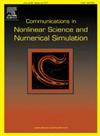The Sun-Earth heteroclinics in restricted four-body non-autonomous models
IF 3.8
2区 数学
Q1 MATHEMATICS, APPLIED
Communications in Nonlinear Science and Numerical Simulation
Pub Date : 2025-09-22
DOI:10.1016/j.cnsns.2025.109356
引用次数: 0
Abstract
This paper presents a combination of analytical and numerical techniques for computing natural heteroclinic connections between Sun–Earth quasi-periodic libration point orbits in non-autonomous restricted four-body models. Focusing on the QBCP problem, we address several computational challenges arising from the system’s periodic time-dependence and close encounters with the primaries. We introduce the concept of mean curve to approximate quasi-Lyapunov orbits and their associated invariant manifolds, providing effective initial guesses for refinement and continuation procedures. This approach remains robust despite difficulties caused by phasing conditions and Moon perturbations. The resulting analysis characterizes the topology and families of planar connections using two physical parameters.
受限四体非自治模型中的太阳-地球异斜
本文提出了一种结合解析和数值的方法来计算非自治约束四体模型中太阳-地球准周期振动点轨道之间的自然异斜联系。在QBCP问题上,我们解决了由于系统的周期性时间依赖性和与主粒子的密切接触而产生的几个计算挑战。我们引入平均曲线的概念来近似拟李雅普诺夫轨道及其相关的不变流形,为精化和延拓过程提供了有效的初始猜测。尽管相位条件和月球扰动造成了困难,但这种方法仍然是稳健的。由此产生的分析利用两个物理参数表征了平面连接的拓扑结构和族。
本文章由计算机程序翻译,如有差异,请以英文原文为准。
求助全文
约1分钟内获得全文
求助全文
来源期刊

Communications in Nonlinear Science and Numerical Simulation
MATHEMATICS, APPLIED-MATHEMATICS, INTERDISCIPLINARY APPLICATIONS
CiteScore
6.80
自引率
7.70%
发文量
378
审稿时长
78 days
期刊介绍:
The journal publishes original research findings on experimental observation, mathematical modeling, theoretical analysis and numerical simulation, for more accurate description, better prediction or novel application, of nonlinear phenomena in science and engineering. It offers a venue for researchers to make rapid exchange of ideas and techniques in nonlinear science and complexity.
The submission of manuscripts with cross-disciplinary approaches in nonlinear science and complexity is particularly encouraged.
Topics of interest:
Nonlinear differential or delay equations, Lie group analysis and asymptotic methods, Discontinuous systems, Fractals, Fractional calculus and dynamics, Nonlinear effects in quantum mechanics, Nonlinear stochastic processes, Experimental nonlinear science, Time-series and signal analysis, Computational methods and simulations in nonlinear science and engineering, Control of dynamical systems, Synchronization, Lyapunov analysis, High-dimensional chaos and turbulence, Chaos in Hamiltonian systems, Integrable systems and solitons, Collective behavior in many-body systems, Biological physics and networks, Nonlinear mechanical systems, Complex systems and complexity.
No length limitation for contributions is set, but only concisely written manuscripts are published. Brief papers are published on the basis of Rapid Communications. Discussions of previously published papers are welcome.
 求助内容:
求助内容: 应助结果提醒方式:
应助结果提醒方式:


